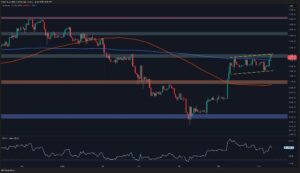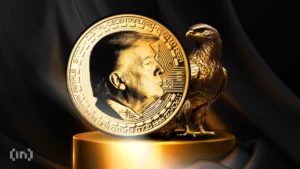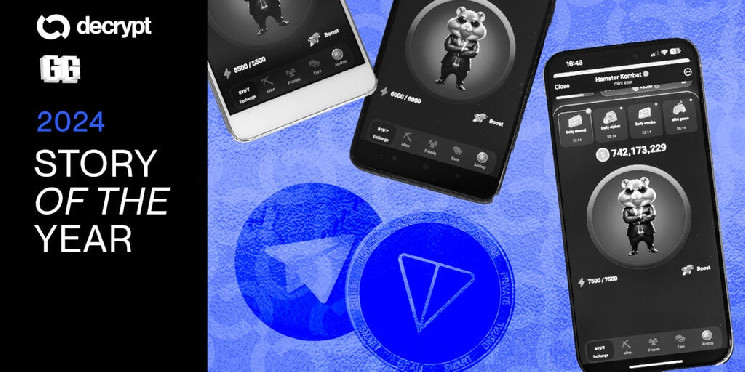At the start of 2024, the first Telegram tap-to-earn game was a curiosity—an enigma. By the end of the year, the success of Notcoin had spawned a mini-industry that had drawn substantial demand. And yet, as quickly as Telegram gaming came, it also went, and it increasingly feels like its moment has passed.
When Notcoin launched back in January, we barely knew what to make of it. Why were people incessantly tapping a coin within a messaging app on their phones? Would there be a real on-chain token, or was this just some kind of meta-commentary on the crypto world?
There would be a real token minted on The Open Network (TON), and Notcoin opted to keep things simple: You tap and you’ll earn. That simplicity, paired with an alluring anti-establishment vibe and growing momentum around TON, ultimately drew 35 million players to the game within just three months.
By the time the Notcoin airdrop delivered hundreds of millions of dollars’ worth of tokens to players, with that value surging to billions of dollars within weeks, tap-to-earn was ready to explode. And that’s where Hamster Kombat picked up the torch.
While still ultimately built around a tapping mechanism, Hamster Kombat shifted gears, taking the form of a very streamlined management sim as you launched and expanded your own crypto exchange—as a fuzzy hamster, of course.
As goofy as that premise sounds, Hamster Kombat hit hard. Within a couple months, the makers boasted of hundreds of millions of players as the game’s social media accounts surged.
And then things got weird.
Massage guns were reportedly selling out in Russia as players used their rhythmic, repetitive vibrations to manipulate Hamster Kombat’s tapping gameplay. And in June, an Iranian military official slammed the game’s growing hold on players in the country, suggesting it would impact the impending presidential election.
“One of the features of the soft war by the enemy is the ‘Hamster’ game,” said Iran’s deputy military chief Rear Adm. Habibollah Sayyari, according to the state-run IRNA news agency.
Telegram gaming was impacting the real world, and by the time Hamster Kombat said it had pulled 300 million total players in July, other games like Catizen and Yescoin were also surging with their own riffs on the premise.
A lot was riding on Hamster Kombat’s airdrop. A smash success would confirm the viability of the tap-to-earn model and its repeatability—that Notcoin wasn’t a fluke, and that a game that pushed into the mainstream could still deliver that kind of value at scale.
Instead, as many players would claim via social media posts, they got “dust.”
Hamster Kombat’s HMSTR airdrop in September delivered hundreds of millions of dollars worth of free tokens to players, effectively creating value out of nothing and rewarding players with real cryptocurrency. But with some 130 million players eligible for the airdrop, it was hardly surprising to see people wind up with maybe a few dollars worth of coins. And they were frustrated.
Every notable Telegram gaming airdrop since Notcoin has been marked with similar discontent. In part, it’s because the airdrops have become so much messier, marked by complications as developers shifted away from the simplicity of Notcoin and attempted to monetize their players, all while funneling them into other games to fuel the hype cycle.
The cat-themed Telegram puzzle game Catizen, for example, pissed off a fair number of players by changing the airdrop eligibility factors right before the token launch, heavily favoring those who had spent real money to pay for perks.
Tomarket said it held its token generation event in October, but then the “tokens” provided to players wouldn’t be tradeable until TOMA had been listed by exchanges. Ultimately, the team admitted that it was an “in-game” token launch and that nothing had been minted to TON—and then a week before the airdrop, Tomarket said that TOMA would be minted on Aptos instead.
As the year comes to an end, the makers of games like Tomarket and MemeFi are trying to explain to their players why their respective tokens aren’t worth much. Meanwhile, early Notcoin followers like Yescoin and Tapswap still haven’t launched their own tokens.
Hamster Kombat, meanwhile, is just sort of stuck in limbo after the airdrop. The team teased a “Season 2” overhaul with new gameplay, but missed its launch target by nearly two months as of this writing, with dwindling player counts and fewer updates in the official Telegram channel. Now the team says it’s launching three games as a “HamsterVerse.”
On top of the repetitive gameplay, the increasingly messy token launches, and players burned by deceptive promises, crypto industry attention has gone elsewhere in a more bullish market—back towards Bitcoin and surging meme coins.
Experts are mixed on the future of tap-to-earn games. Some have said that the games need to be more engaging and more robust; others suggest that such simple tapping mechanisms should only be used as an onboarding and engagement tool for new platforms and projects.
Tap-to-earn gaming repackaged the play-to-earn craze from 2021, streamlining and simplifying the concept and making it more palatable for the masses. It worked, if only briefly, but a lot of the same underlying issues ultimately reared their head.
Is the next Notcoin just around the corner in 2025? Perhaps. But players and creators alike learned some tough lessons from the initial boom, and any illusions about tapping your way to crypto riches have quickly faded.
Read the full article here









